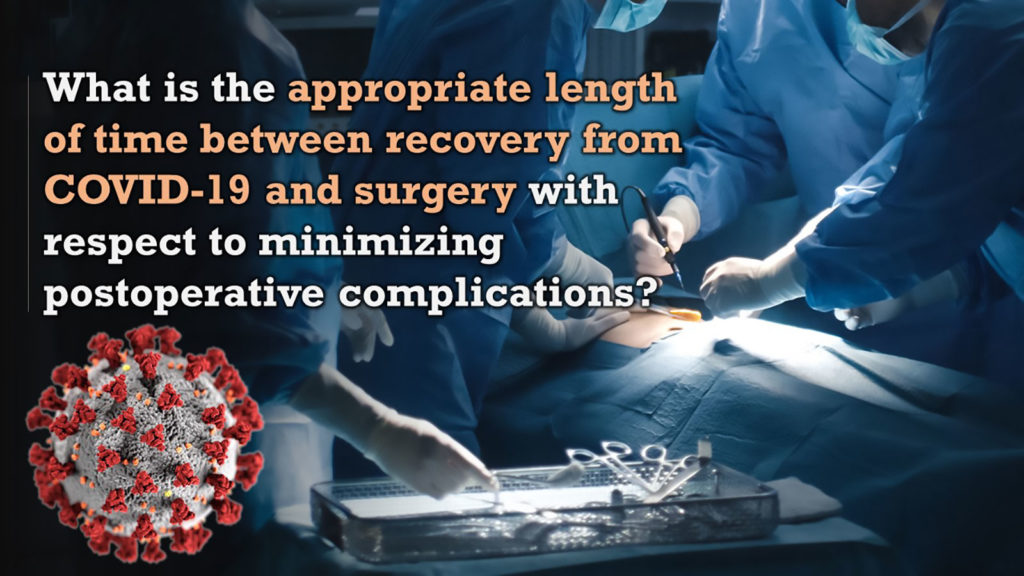Originally published: March 9, 2021
Last updated: February 22, 2022; June 20, 2023
American Society of Anesthesiologists and Anesthesia Patient Safety Foundation Joint Statement on Elective Surgery/Procedures and Anesthesia for Patients after COVID-19 Infection
June 20, 2023These revised recommendations recognize extensive public vaccination, less virulent variants in the post-Omicron phase, and recent evidence to allow anesthesiologists and others to critically and objectively assess whether surgery or procedure can occur before seven weeks after SARS-CoV-2 infection.1,2 We recognize the contributions of US and international partners to address continued patient access to perioperative care and treatment. These recommendations are similar to, and aligned with, recent publications in the United Kingdom.3
These revised recommendations do not diminish the significance of a SARS-CoV-2 infection or the effects that an infection may have on individual patients.4,5,6,7,8,9,10 Clinical decision-makers, including patients, should discuss the risks and benefits of proceeding with a procedure before seven weeks. Anesthesiologists must maintain their vigilance and focus on ensuring patient safety, reducing the risk of perioperative complications, and improving surgical outcomes.
Elective surgeries should be performed for patients who have recovered from COVID-19 only when the anesthesiologist, surgeon or proceduralist, and patient jointly agree to proceed. Ideally, surgical patients should be up to date with their vaccinations at least two weeks before their surgical procedure.11 The decision for surgery/procedure depends on two factors: 1. Is the patient infectious? and 2. For patients that are no longer infectious, what is the appropriate time to wait between recovery from COVID-19 and surgery/procedure in terms of risk to the patient?
We offer the following recommendations to assist in that decision-making process.
| RECOMMENDATIONS | |
|
What determines when a patient confirmed to have COVID-19 is no longer infectious?
The Centers for Disease Control and Prevention (CDC) provides guidance for physicians to decide when transmission-based precautions (e.g., isolation, use of personal protective equipment, and engineering controls) may be discontinued for hospitalized patients, or home isolation may be discontinued for outpatients.13
Maintaining transmission-based precautions and repeat testing may be appropriate if clinical suspicion of ongoing infection exists. The treating physician should determine the degree of immunocompromise of the patient and preventive actions should be tailored to each individual and situation. Factors such as advanced age, diabetes mellitus, or end-stage renal disease may pose a much lower degree of immunocompromise, and their effect on the duration of infectivity for a given patient is not known. Clinical judgment ultimately prevails when deciding whether a patient remains infectious.
Consultation with infection control experts is advised before discontinuing precautions for patients with severe to critical illness or who are moderately to severely immunocompromised. Physicians should also be aware of residual COVID-19 symptoms, include post-COVID conditions (PCCs) that patients may encounter. PCCs have many etiologies, and symptoms may last from four to 12 weeks after infection. The CDC estimates that 5-30% of infected patients experience PCCs.14,15,16,17
What is the appropriate length of time between recovery from COVID-19 and surgery/procedure with respect to minimizing postoperative complications?
These revised recommendations encourage continued vigilance and study of surgical and procedural care after SARS-CoV-2 infection. The preoperative preparation of a surgical patient who is recovering from COVID-19 involves evaluation and optimization of the patient’s medical conditions and physiologic status. Since COVID-19 can impact virtually all major organ systems, the timing of surgery after a COVID-19 diagnosis is important when considering the risk of postoperative complications. Heretofore, protocols have been based on limited data specific to SARS-CoV-2, expert opinion, and previous data from other post-viral syndromes.
These revised recommendations support facilities, surgeons, and anesthesiologists conducting risk assessments on patients who may benefit from surgeries or procedures between two and seven weeks after COVID-19 infection. Such risk assessments should take into consideration patient factors, infection factors, and surgical factors. Risk assessments should be completed using a validated tool such as the Surgical Outcome Risk Tool v2 (SORT-2) or ACS-NSQIP Surgical Risk Calculator. Ideally, risk assessments should occur at the time of scheduling to ensure appropriate prehabilitation of the patient.3 Only low-risk patients undergoing a low-risk surgery or procedure should be eligible for scheduling within two to seven weeks after SARS-CoV-2 infection.
References
- Garnier M, Constantin J-M, Cinotti R et al. Association of preoperative COVID-19 and postoperative respiratory morbidity during the Omicron epidemic wave: the DROMIS-22 multicentre prospective observational cohort study. eClinicalMedicine 2023; 58: 101881
- Centers for Disease Control and Prevention. Variants of the Virus. Updated February 6, 2023. https://www.cdc.gov/coronavirus/2019-ncov/variants/index.html. Accessed May 13, 2023.
- El-Boghdadly K, Cook TM, Goodacre T, Kua, J, Denmark S, Mercer N, Moonesinghe SR, Summerton DJ. Timing of elective surgery and risk assessment after SARS-CoV-2 infection: 2023 update A multidisciplinary consensus statement on behalf of the Association of Anaesthetists, Federation of Surgical Specialty Associations, Royal College of Anaesthetists and Royal College of Surgeons of England. https://associationofanaesthetists-publications.onlinelibrary.wiley.com/doi/full/10.1111/anae.16061. Accessed June 20, 2023.
- SenthilKumar G, Verhagen NB, Sheriff SA et al. Preoperative SARS-CoV-2 infection increases risk of early postoperative cardiovascular complications following non-cardiac surgery. American Journal of Physiology-Heart and Circulatory Physiology 2023; 4: 88–100.
- Prasad NK, Lake R, Englum BR, Turner DJ, Siddiqui T, Mayorga-Carlin M, Sorkin JD, Lal BK. COVID-19 vaccination associated with reduced postoperative SARS-CoV-2 infection and morbidity. Ann Surg. 2022 Jan 1;275(1):31-36. doi: 10.1097/SLA.0000000000005176. PMID: 34417362; PMCID: PMC8678152.
- COVIDSurg Collaborative. Delaying surgery for patients with a previous SARS-CoV-2 infection. British Journal of Surgery 2020;107:e601–2. https://doi.org/10.1002/bjs.12050
- Baiocchi G, Aguiar S Jr, Duprat JP, Coimbra FJF, Makdissi FB, Vartanian JG, Zequi SC, Gross JL, Nakagawa SA, Yazbek G, Diniz TP, Gonçalves BT, Zurstrassen CE, Campos HGDA, Joaquim EHG, França E Silva IA, Kowalski LP. Early postoperative outcomes among patients with delayed surgeries after preoperative positive test for SARS-CoV-2: A case-control study from a single institution. J Surg Oncol. 2021 Mar;123(4):823-833. doi: 10.1002/jso.26377. Epub 2021 Jan 11. PMID: 33428790; PMCID: PMC8014861.
- COVIDSurg Collaborative, GlobalSurg Collaborative. Timing of surgery following SARS-CoV-2 infection: an international prospective cohort study. Anaesthesia 2021;76:748–758. doi: 10.1111/anae.15458. Epub 2021 Mar 9. PMID: 33690889; PMCID: PMC8206995.
- Deng JZ, Chan JS, Potter AL, Chen Y-W, Sandhu HS, Panda N, Chang DC, Yang, CF J. The risk of postoperative complications after major elective surgery in active or resolved COVID-19 in the United States. Ann Surg 2022;275:242-246. doi: 10.1097/SLA.0000000000005308. PMID: 34793348; PMCID: PMC8745943.
- McInerney DC, Kotzé A, Bacon S, Cutting JE, Fisher L, Goldacre B, Johnson OA, Jua J, McGuckin D, Mehrkar A. Postoperative mortality and complications in patients with and without pre-operative SARS-CoV-2 infection: a service evaluation of 24 million linked records using OpenSAFELY. Anaesthesia. 2023;78(6):692-700. doi:10.1111/anae.16001. PMID: 36958018.
- Centers for Disease Control and Prevention. Stay Up to Date with COVID-19 Vaccines. June 7, 2023. Stay Up to Date with COVID-19 Vaccines | CDC. Accessed June 8, 2023.
- American Society of Anesthesiologists, Anesthesia Patient Safety Foundation. ASA and APSF Statement on Perioperative Testing for the COVID-19 Virus. June 15, 2022 https://www.asahq.org/about-asa/newsroom/news-releases/2022/06/asa-apsf-statement-on-perioperative-testing-for-covid. Accessed June 6, 2023.
- Centers for Disease Control and Prevention. Ending Isolation and Precautions for People with COVID-19: Interim Guidance. August 31, 2022. https://www.cdc.gov/coronavirus/2019-ncov/hcp/duration-isolation.html. Accessed April 28, 2023.
- Centers for Disease Control and Prevention. Post-COVID Conditions: Information for Healthcare Providers. Updated December 16, 2022. https://www.cdc.gov/coronavirus/2019-ncov/hcp/clinical-care/post-covid-conditions.html. Accessed May 13, 2023.
- Tenforde MW, Kim SS, Lindsell CJ., et al. Symptom Duration and Risk Factors for Delayed Return to Usual Health Among Outpatients with COVID-19 in a Multistate Health Care Systems Network – United States, March-June 2020. MMWR 2020 Jul 31;69(30):993-998. https://dx.doi.org/10.15585%2Fmmwr.mm6930e1.
- Carfì A, Bernabei R, Landi F, for the Gemelli Against COVID-19 Post-Acute Care Study Group. Persistent Symptoms in Patients After Acute COVID-19. JAMA. 2020;324(6):603–605. doi:10.1001/jama.2020.12603.
- Puntmann VO, Carerj ML, Wieters I, et al. Outcomes of Cardiovascular Magnetic Resonance Imaging in Patients Recently Recovered From Coronavirus Disease 2019 (COVID-19). JAMA Cardiol. 2020;5(11):1265-1273. doi:10.1001/jamacardio.2020.3557.

 PDF
PDF

